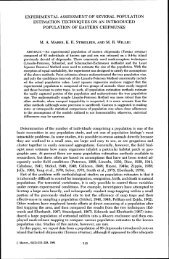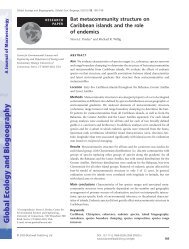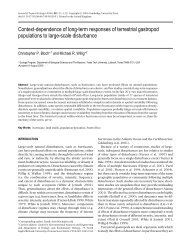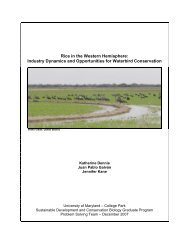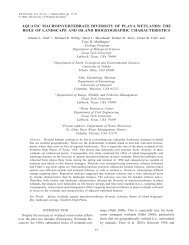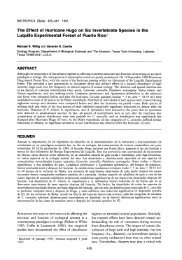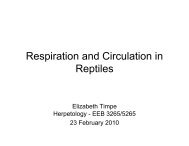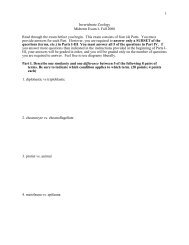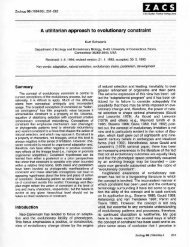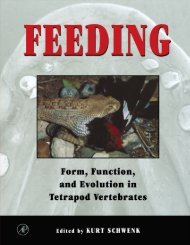Tadpole shrimp structure macroinvertebrate communities in playa ...
Tadpole shrimp structure macroinvertebrate communities in playa ...
Tadpole shrimp structure macroinvertebrate communities in playa ...
You also want an ePaper? Increase the reach of your titles
YUMPU automatically turns print PDFs into web optimized ePapers that Google loves.
142<br />
effects were not significant, however, and subsequently<br />
dropped from analyses.<br />
For control trials, we calculated Spearman rank<br />
correlation coefficients to quantify the association<br />
between tadpole <strong>shrimp</strong> density and abundance of<br />
each taxon, taxonomic richness, evenness, diversity,<br />
dom<strong>in</strong>ance, or total <strong>in</strong>vertebrate abundance (SAS<br />
Institute, 1990). Results from the two control trials<br />
were comb<strong>in</strong>ed us<strong>in</strong>g Fisher’s test for comb<strong>in</strong><strong>in</strong>g<br />
probabilities (Sokal & Rohlf, 1995). Partial correlation<br />
coefficients also were calculated to assess direct<br />
effects of tadpole <strong>shrimp</strong> on each taxon after<br />
remov<strong>in</strong>g <strong>in</strong>direct effects via other taxonomic groups.<br />
Results<br />
Aside from tadpole <strong>shrimp</strong>, approximately 16000<br />
aquatic <strong>in</strong>vertebrates represent<strong>in</strong>g 17 taxonomic<br />
groups were collected from <strong>playa</strong> microcosms<br />
(Table 1). The most abundant groups, <strong>in</strong> descend<strong>in</strong>g<br />
order of abundance, were Mo<strong>in</strong>idae (Cladocera),<br />
Cyprididae (Ostracoda), Diaptomidae<br />
(Copepoda), Sm<strong>in</strong>thuridae (Collembola), Streptocephalidae<br />
(Anostraca), and Ilyocyprididae (Ostracoda).<br />
<strong>Tadpole</strong> <strong>shrimp</strong> significantly affected community<br />
characteristics (richness, evenness, diversity,<br />
dom<strong>in</strong>ance, and total <strong>in</strong>vertebrate abundance),<br />
despite considerable variability among <strong>playa</strong>s<br />
(Tables 2 and 3). Multivariate analysis of variance<br />
<strong>in</strong>dicated community characteristics were significantly<br />
different between treatments and among<br />
<strong>playa</strong>s, but differences between trials only<br />
approached significance (Table 3). There was no<br />
significant <strong>playa</strong> x treatment <strong>in</strong>teraction, <strong>in</strong>dicat<strong>in</strong>g<br />
effects of tadpole <strong>shrimp</strong> removal were consistent<br />
among <strong>playa</strong>s (Table 3). Subsequent<br />
Table 1. Taxonomic composition of microcosms <strong>in</strong> which abundances of tadpole <strong>shrimp</strong> were reduced compared to controls <strong>in</strong> which<br />
no density reductions were <strong>in</strong> effect<br />
<strong>Tadpole</strong> <strong>shrimp</strong> reduction Control<br />
Trial 1 Trial 3 Trial 2 Trial 4<br />
Taxonomic group Num. Freq. Num. Freq. Num. Freq. Num. Freq.<br />
Turbellaria 0 0 2 2 2 1 16 9<br />
Acar<strong>in</strong>a 1 1 0 0 0 0 0 0<br />
Crustacea<br />
Anostraca Streptocephalidae 118 16 61 12 28 11 173 21<br />
Thamnocephalidae 12 1 0 0 2 2 3 2<br />
Notostraca Triopsidae 44 22 23 13 114 34 84 26<br />
Conchostraca Caenestheriidae 2 2 0 0 8 3 1 1<br />
Cladocera Daphnidae 47 16 4 1 77 5 19 6<br />
Mo<strong>in</strong>idae 2655 40 2364 28 3494 41 2662 34<br />
Unknown family 0 0 4 3 1 1 3 3<br />
Ostracoda Cyprididae 789 39 929 40 439 37 567 38<br />
Ilyocyprididae 45 13 126 21 46 15 76 24<br />
Copepoda Diaptomidae 172 25 304 33 364 34 364 31<br />
Insecta<br />
Collembola Sm<strong>in</strong>thuridae 26 6 23 7 176 21 237 20<br />
Coleoptera Curculionidae 2 1 0 0 0 0 1 1<br />
Diptera Chironomidae 0 0 0 0 18 1 0 0<br />
Culicidae 1 1 0 0 0 0 0 0<br />
Ephydridae 0 0 1 1 10 4 19 3<br />
Psychodidae 0 0 5 3 0 0 0 0<br />
Number (Num.) refers to the total abundance of <strong>in</strong>dividuals obta<strong>in</strong>ed from 41 replicate microcosms. Frequency of occurrence (Freq.)<br />
represents the number of microcosms that conta<strong>in</strong>ed particular taxa.



